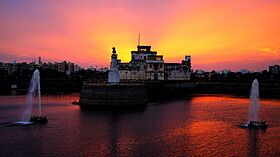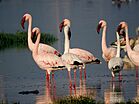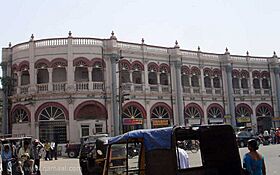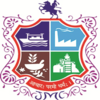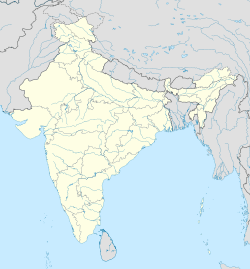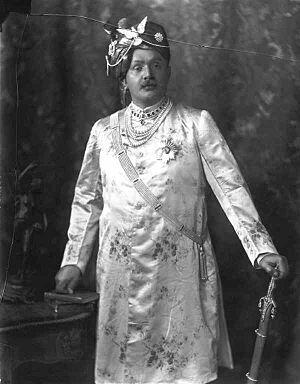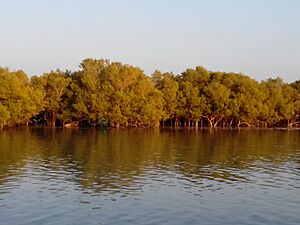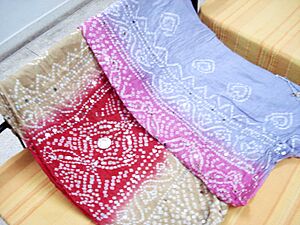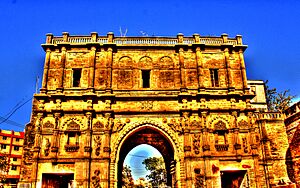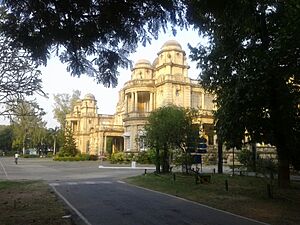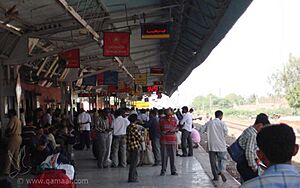Jamnagar facts for kids
Jamnagar (pronounced Jaa-muh-nuh-gur) is a city in the Indian state of Gujarat. It's the main city of the Jamnagar district and is located just south of the Gulf of Kutch. The city is about 337 kilometers west of Gandhinagar, the capital of Gujarat. Jamnagar was once the capital of a princely state called Nawanagar during the time of British rule in India.
Jamnagar is home to some very important places. India's largest private company, Reliance Industries, has the world's biggest oil refining and petrochemicals complex here. The World Health Organization (WHO) and the Indian government also set up a special global center in Jamnagar for traditional medicine. This center uses modern science to study and improve traditional healing methods from all over the world. Reliance Industries is also building the world's largest zoo near Jamnagar.
A luxury hotel chain, Lemon Tree Hotels, opened a new hotel in Jamnagar in 2025. The Jamnagar Municipal Corporation is also planning to develop the riverfront along the Rangmati and Nagmati rivers.
Quick facts for kids
Jamnagar
Brass City of India
|
||
|---|---|---|
|
City
|
||
|
Clockwise from top: Lakhota Lake, Lesser Flamingos, Darbar Garh Market, Swaminaryan Temple
|
||
|
||
| Nickname(s):
Jewel of Kathiawar, Paris of Saurashtra, Oil City, Brass City, Chhota Kashi, Halar
|
||
| Country | ||
| State | Gujarat | |
| Region | Saurashtra | |
| District | Jamnagar | |
| Established | August 1540 | |
| Founded by | Jam Rawal Jadeja | |
| Government | ||
| • Type | Mayor–Council | |
| • Body | Jamnagar Municipal Corporation | |
| Area | ||
| • Total | 125 km2 (48 sq mi) | |
| Area rank | 6 | |
| Elevation | 17 m (56 ft) | |
| Population
(2023)
|
||
| • Total | 668,000 (City Area) | |
| • Rank | India : 87th |
|
| • Density | 5,780/km2 (15,000/sq mi) | |
| Demonym(s) | Jamnagari | |
| Time zone | UTC+5:30 (IST) | |
| PIN |
361 001-09
|
|
| Telephone code | 0288 | |
| Vehicle registration | GJ-10 | |
Contents
History of Jamnagar
Jamnagar was first known as Nawanagar, meaning "the new town." It was founded in 1540 by a ruler named Jam Rawal. Nawanagar was one of the most important princely states in the Saurashtra region, ruled by the Jadeja family.
How Jamnagar Was Founded
The story of Jamnagar's founding is quite interesting. Jam Rawal's father, Jam Lakhaji, was given twelve villages by the Sultan of Gujarat. But his cousins, Tamachi Deda and Jam Hamir Jadeja, killed him. Jam Rawal later got revenge by killing his father's murderers. He then became the ruler of Kutch.
Hamirji's sons, Khengarji and Sahibji, served the Sultan of Gujarat. One day, they bravely saved the Sultan from a lion during a hunt. As a reward, the Sultan sent an army with them to help them get their kingdom back from Jam Rawal.
Jam Rawal had a dream where the goddess Ashapuraji told him he could no longer stay in Kutch. So, he and his people left Kutch. On their journey, they defeated Tamachi Deda. Jam Rawal also took over the town of Amran and gave the Dhrol province to his younger brother, Hardholji. Jam Rawal then conquered parts of Saurashtra and created his own kingdom with 999 villages, which he called Halar.
One day, while hunting in the area that is now Jamnagar, Jam Rawal saw something amazing. His hunting dogs were chasing a hare, but the hare was so brave that it turned around and scared the dogs away! Jam Rawal thought that if the land could produce such brave hares, then the people born there would be even braver. Because of this, he decided to make this place his new capital.
In August 1540, Jam Rawal officially started building his new capital on the banks of the Rangmati and Nagmati rivers. He named it Nawanagar. Many centuries later, its name changed to Jamnagar, which means "Town of the JAMs" (referring to the Jadeja rulers).
Jamnagar Under British Rule
In 1807, Nawanagar became a princely state under the British Raj. One of its most famous rulers was Maharaja Ranjit Singhji. He was known for his modern ideas and worked hard to improve the state. He built many schools, hospitals, and other public places.
Later, in the 1920s, another ruler named Jamsaib helped create the city's modern buildings and roads. Jam Saheb Shri Digvijaysinhji Ranjitsinhji continued this development in the 1940s.
Geography and Nature
Jamnagar is home to many different communities. The city is close to two important ports: Rozi Port on the Gulf of Kutch and Bedi Port on the Rangamati River. Bedi Port is a busy seaport that handles exports like bauxite and imports like coal.
Marine Life and Birds
The coral reef island of Pirotan is part of the Marine National Park. This park has 42 islands known for their beautiful coral reefs and mangrove forests. Pirotan is about 12 nautical miles off the coast.
The Khijadia Bird Sanctuary is located about 10 kilometers northeast of Jamnagar. It's a wonderful place for birdwatching. It has a freshwater lake, mudflats, and mangrove areas. Many birds, like the Great Crested Grebe, Purple Moorhen, and Black-winged Stilt, breed here. You can also see birds of prey like Harriers and Eagles. During certain seasons, many migratory birds, such as Swallows and Wagtails, visit the sanctuary.
Jamnagar also has large amounts of bauxite, which is a rock used to make aluminum. The mines here produce 95% of all the bauxite in Gujarat.
Climate in Jamnagar
Jamnagar has a hot, semi-dry climate. There are three main seasons. From March to May, it's very hot and humid. Then comes the wet season, from June to September, with rainfall that can vary a lot. Sometimes, tropical storms can affect the area during this time. The cool season is from October to February. During this time, days are hot, but nights are cool, and there's very little rain.
The highest temperature ever recorded in Jamnagar was 47 degrees Celsius (117°F) on May 5, 1990. The lowest was 1 degree Celsius (34°F) on February 5, 1984.
People of Jamnagar
In 2023, the population of Jamnagar's urban area was about 668,000 people. Most people in Jamnagar can read and write, with a literacy rate of over 82%. This is higher than the national average in India. About 53% of the population is male and 47% is female.
Most residents speak Gujarati, the official language of Gujarat. Some people also speak Kutchi, which is a different language but uses the Gujarati writing system. The local way of speaking Gujarati, called Kathiawadi, is commonly used for daily conversations.
Economy and Industries
Jamnagar's economy has changed a lot over time. Many people who used to be fishermen now work in industries that have grown in the city. About 10% of the city's population makes a living by creating and selling traditional Bandhani cloth. This cloth is known for its beautiful tie-dye patterns. Digjam, a company that makes wool fabrics, also has a factory in Jamnagar.
Jamnagar is often called the "Brass City." This is because it has thousands of workshops that make brass items. These workshops produce brass parts and rods that are even exported to other countries. Jamnagar is the biggest producer of brass items in India.
The city is also known as the "World's Oil City." This is because it has the world's largest oil refineries. The Jamnagar Refinery, owned by Reliance Industries, started operating in 1999 and is the biggest refinery globally. Nayara Energy also owns the Vadinar Refinery, which is India's second-largest single-site refinery.
Jamnagar is important for India's defense, with bases for the Indian Air Force, Indian Army, and Indian Navy. Its location near Pakistan makes it strategically important.
Arts and Culture
Religion in Jamnagar
Jamnagar has many temples. Some famous Hindu temples include Sidhnath Mahadev Temple and Bhid Bhanjan Mahadev Temple. The city is also well-known for its four beautiful marble Jain temples, built between 1574 and 1622. In total, there are over 30 Jain temples in Jamnagar.
The Bala Hanuman Temple is famous for its continuous chanting of the mantra "Sri Ram, Jai Ram, Jai Jai Ram." This chanting has been going on 24 hours a day since August 1, 1964, earning the temple a place in the Guinness Book of World Records. Many people visit this temple every year.
Architecture in Jamnagar
The Bohra Hajira is a white marble tomb built in 1540 by Jam Rawal. It's the resting place of a Muslim saint named Mota Bawa. This building has a beautiful Saracenic style with detailed carvings. The Jamnagar Trimandir is a two-story building with a large hall and a temple. The Khambhaliya Gate, built in the 17th century, is one of the two city gates still standing from that time.
Pratap Vilas Palace was built during the rule of Ranjitsinhji. It mixes European style with Indian carvings. Its domes are in the traditional Indian style, and three of them are made of glass. The palace columns have carvings of plants, flowers, birds, and animals. Willingdon Crescent, now known as Darbargarh Market, was built by Ranjit Singh to replace an older area. It's an arcade with curved arches and a statue of Jam Saheb in the center.
Sports in Jamnagar
Cricket is a very popular sport in Jamnagar. Many famous Indian cricketers, like Vinoo Mankad, Ajay Jadeja, and Ravindra Jadeja, come from this city. The Ajitsinhji Pavilion cricket ground was built in 1908. The famous Indian cricket tournaments, the Ranji Trophy and Duleep Trophy, are named after princes from Jamnagar.
The city has a sports complex with a swimming pool and badminton courts. There's also an old sports club called Summair Sports Club, built by the former rulers. It has facilities for swimming, tennis, squash, and billiards.
Parks and Recreation
The Kotha Bastion museum has old sculptures, coins, and other historical items, including the skeleton of a whale. The Lakhota Museum, located in the former Lakhota Palace, displays sculptures from the 9th to 18th centuries, old weapons, and pottery.
The Marine National Park in the Gulf of Kutch is India's first marine sanctuary. It's about 7 kilometers from the city center and includes 42 islands known for their coral reefs and mangroves. This area attracts many birds, dolphins, sea turtles, and colorful tropical fish.
Education
Jamnagar has many schools, including Jawahar Navodaya Vidyalaya, Podar International School, and St. Xavier's High School. The city also has colleges for dental studies, health, arts, commerce, and science. Gujarat Ayurved University is a well-known institution here.
Infrastructure
Transportation
The Amritsar–Jamnagar Expressway (NH-754) is a major new highway that was completed in 2023. This 6-lane expressway connects Amritsar and Jamnagar, significantly reducing travel time. It passes through Punjab, Haryana, Rajasthan, and Gujarat. This expressway is important because it connects three large oil refineries, including the one in Jamnagar.
Jamnagar has many private bus services connecting it to major cities like Ahmedabad, Mumbai, and Pune. The State Transport also provides bus services across Gujarat. Local buses are run by the Jamnagar Municipal Corporation. You can also find Ola Cabs and auto rickshaws for local travel.
The Jamnagar railway station connects the city to various parts of India. There are daily trains to Mumbai and weekly trains to other major cities. Jamnagar also has an airport with daily flights to Mumbai and flights to Hyderabad and Bengaluru several times a week. The airport is part of an Indian Air Force base.
Utilities and Media
The Sikka Thermal Power Station, a coal-fired power plant, is located near Jamnagar. For entertainment, various cable operators and DTH services like Tata Play are available. Bharat Sanchar Nigam Limited (BSNL) provides broadband internet. All major mobile operators, including Vi, Airtel, and BSNL, offer services in Jamnagar.
Jamnagar has several radio stations, including All India Radio, Top FM, and Radio Mirchi. You can also find daily local and national newspapers in multiple languages, such as The Times of India and Indian Express. Local Gujarati newspapers include Aajkaal and Jamnagar Bhaskar. The Princely State is the local English newspaper.
Notable People
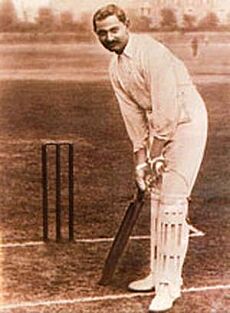
Many famous people were born or have lived in Jamnagar, including:
- Ruskin Bond, a well-known author
- Ranjitsinhji, a former King of Nawanagar and the first Indian international cricketer who played for England
- Vinoo Mankad, a famous former cricketer
- Duleepsinhji, another former cricketer
- Salim Durani, an Indian former test cricketer
- Remo D'Souza, a dancer, choreographer, actor, and film director
- Ajay Jadeja, a former ODI cricketer
- Ravindra Jadeja, a current Indian cricketer
- Digvijaysinhji Ranjitsinhji, also known as The Good Maharaja, who helped many Polish children during World War II.
Images for kids
See also
 In Spanish: Jamnagar para niños
In Spanish: Jamnagar para niños


